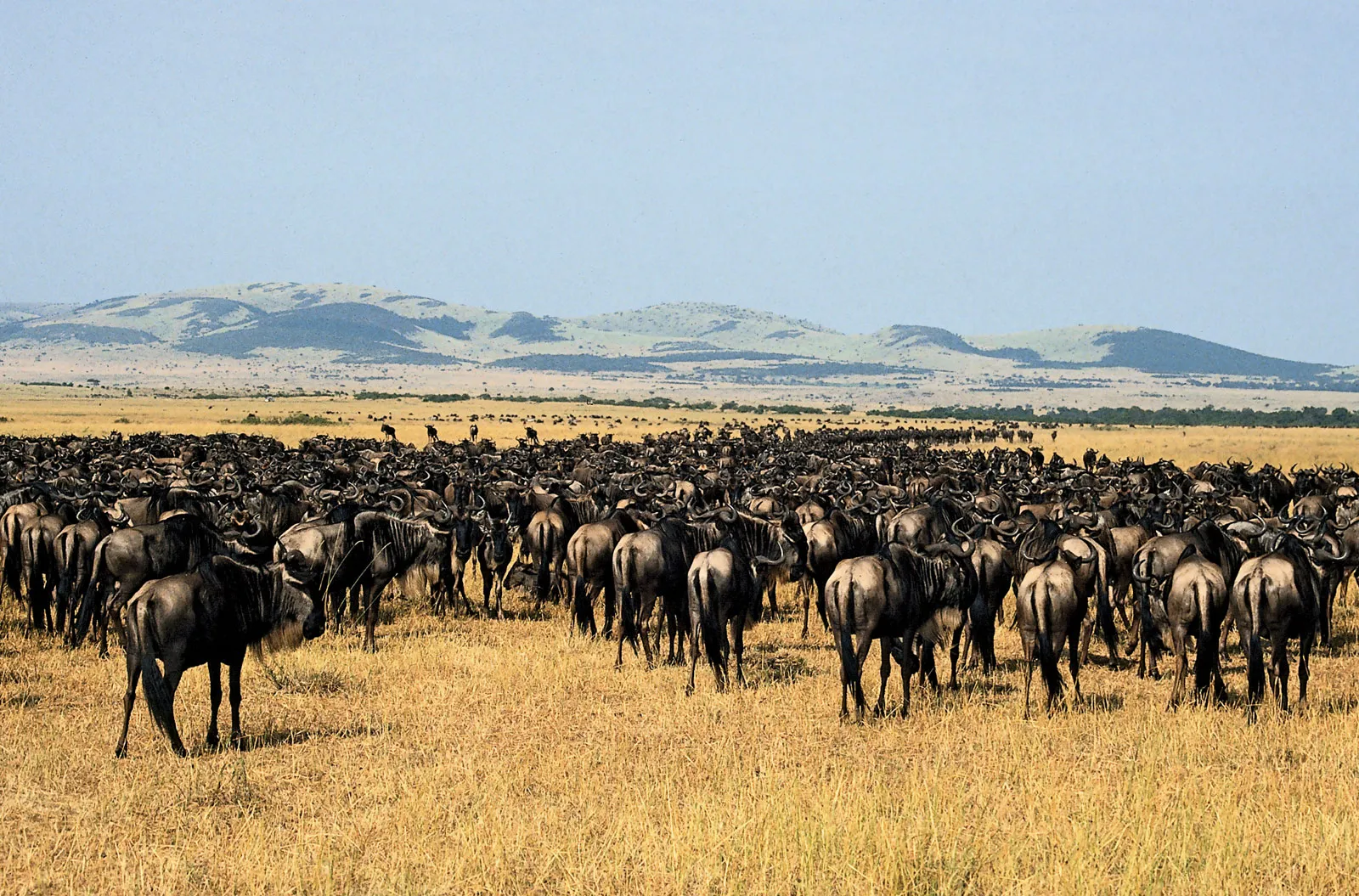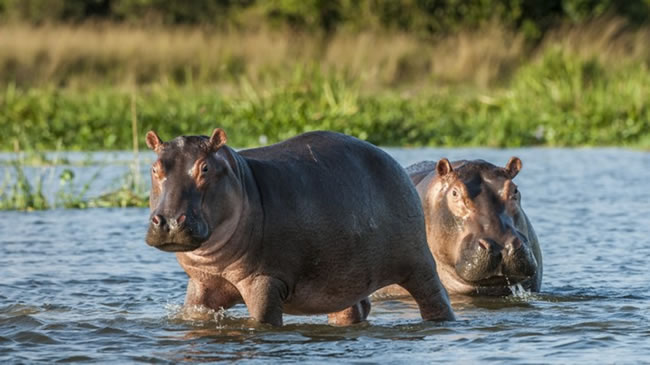Arusha National Park, located northeast of Arusha, is the most accessible national park on Tanzania's…

Serengeti national park
The Serengeti National Park Tanzania is a UNESCO World Heritage site and a world-renowned wildlife experience destination, also known as the wildlife capital. This park is located in northwestern Tanzania, along the northern Kenyan frontier, where it is continuous with the Masai Mara National Reserve. Serengeti national park is bordered by the Ngorongoro conservation area to the south-east, the Maswa game reserve to the southwest, the Ikorongo and Gumet game reserves to the northeast, and the Loliondo game control area to the east.
Serengeti national park is the quintessential safari destination in Tanzania, encompassing 14,763 square kilometers of grasslands, savannah, riverine forest, and woodlands. Serengeti national park is the epitome of an African wildlife safari destination, consisting of endless plains defined by the Masai word siringet, which means endless plains or the location where the land runs forever.
According to historical records, the Masai people grazed their livestock on the open expanses of the eastern Mara region on the lands of Serengeti national park for over two centuries. Sir Stewart Edward White was the first American to enter Serengeti national park, and his explorations in northern Serengeti are documented in 1913. Prior to 1913, little is known about the plains of Serengeti national park, as professional hunters began visiting the area to hunt a variety of animals inhabiting the area. In 1920, he returned to Serengeti national park and camped near Seronera for three months. During his stay, he and his companions shot approximately fifty lions, resulting in a depletion of lions in the region. In 1952, the entire Serengeti national park was established as a result of the British Colonial Administration’s declaration of a game reserve covering 3.2 square kilometers.
In the 1950s, the novella and film “Serengeti Shall Not Due” by Bernhard Grzimek and his son Michael increased the park’s popularity.
Serengeti national park comprises of a scenic landscape comprises of Lobo valley, Barfafu Gorge and Kopjes, Matiti plains, olduvai gorge, makoma hill, kusini plains, lake Ndutu, lower Grumeti woodlands, retina hippo pool, Seronera valley, Lamai triangle, upper grumeti woodlands and kopjes such as Moru kopjes, Masai kopjes, Gol kopjes and Simba kopjes.
Serengeti national park is one of the best destinations for Tanzania wildlife safaris in Tanzania and the globe. It is home to a wide variety of mammals, including the Big Five, carnivores, primates, and reptiles. Mammals found in Serengeti national park include lions, elephants, leopards, buffaloes, rhinos, topis, elands, coke’s hartebeests, giraffes, impalas, warthogs, various species of antelopes such as roan antelopes, common eland, bushbucks, greater kudus, fringe- eared oryxes and dik-dik, aardvark, aardwolf, bat-eared fox, ground pangolin, crested porcupine, 3 species of hyraxes, cape hare and many more. Serengeti national park is home to numerous species of reptiles, including leopard tortoise, serrated hinged teerapin, crocodiles, African python, black-necked spitting cobras, puff ander, and black mamba, among others.
The great wildebeest migration is one of the major tourist attractions that makes Serengeti national park a fantastic destination for wildlife viewing. Wildebeest migration entails the movement of more than 1.5 million individuals, including 250,000 plains zebras, 300,000 Thomson gazelles, and more than 500,000 wildebeests in the Serengeti-Mara ecosystem.
Serengeti national park is also one of the top listed Tanzania birding safari destination habiting over 500 bird species, these birds include Masai ostrich, marabou storks, black crake, lesser flamingo, Ashy starling, love birds, yellow barbets, crowned cranes, helmeted guinea fowls, southern ground hornbill, kori bustards, secretary birds, oxpeckers, small finches, hartlaub’s turaco and many more.
Safari activities to do in Serengeti national park
Game drives
Game drives in Serengeti national park are one of the most well-known Tanzania safari activities conducted in this incredible park; game drives are conducted in 4X4 wheel cars touring the park’s four major regions: Seronera and the south, Grumeti and the western corridor, central Serengeti, and northern Serengeti. Game drives are available.
The best opportunity to see big cats such as lions, leopards, and cheetahs hunting and sunbathing is during the morning game drive.
After lunch, a game drive is conducted in the afternoon. A full-day game drive provides the chance to see a variety of animals, including zebras, leopards, elephants, and many others.
This game drive is ideal for spotting nocturnal animals such as lions, leopards, cheetahs, and many others, as it is conducted during the dark night hours with the aid of a spotlight.
Generally game drives in Serengeti national park offers sights of many animals such aslions, elephants, leopards, buffaloes, rhinos, topis, elands, coke’s hartebeests, giraffes, impalas, warthogs, various species of antelopes such as roan antelopes, common eland, bushbucks, greater kudus, fringe- eared oryxes and dik-dik and many more.
Birding
Serengeti National Park is one of the top birding destinations for Tanzania birding safaris; it is a haven for birdwatchers and home to more than 500 species residing in the park’s diverse ecosystem. Birding in Serengeti National Park provides views of numerous species of birds, including Masai ostrich, marabou storks, black crake, lesser flamingo, Ashy starling, love birds, yellow barbets, crowned cranes, helmeted guinea fowls, southern ground hornbill, Kori bustards, secretary birds, Oxpeckers, small finches, Hartlaub’s turaco, and many others.
Birding in Serengeti national park begins as early as 6:00 am, when most birds are just waking up. The best time to go birding in the park is from November to April, which is the breeding season for most birds. Migratory birds from Europe and other parts of Africa are also present in the park.

Hot air balloon safaris
This breathtaking safari experience offers aerial views of Serengeti national park’s wilderness, including lions, elephants, buffaloes, and cheetahs, as well as the magnificent landscape. This experience lasts approximately 1-2 hours and is followed by a champagne breakfast in the bush. Hot air balloon safaris in Serengeti national park commence as early as 6 am from designated sites in the Seronera region.
There are three designated locations in Serengeti national park for hot air balloon safaris.
In central Serengeti, over the Seronera river valley, one can observe animals congregating around the river while hovering over Seronera.
Western Serengeti flying over Grumenti River in June and July to observe the wildebeest migration traversing the river.
8000 newborns are spotted during the calving period of the great wildebeest migration while soaring over the southern plains of the Serengeti.
Hot air balloon excursions are ideal for photographers who want to capture breathtaking images of nature.
Walking safaris
Walking safaris in Serengeti national park are the best way to explore every inch of the park that a safari vehicle cannot reach. This exhilarating experience provides views of Serengeti’s wildlife, including lions, elephants, and many others. Walking excursions are conducted under the supervision of a game ranger and a guide.
Cultural excursions
Cultural tours in Serengeti national park provide insight into the traditional way of life of the Maasai people and are the finest way to experience the Maasai way of life. Prior to the establishment of national parks, the Maasai were a semi-nomadic people who lived in various regions of Kenya and Tanzania. Visiting Maasai villages known locally as Bomas affords visitors the chance to interact with Maasai locals, participate in activities such as livestock rearing, and be enlivened by local dance and drama. In addition, tourists learn more about Maasai customs, rituals, and traditions, among others.
Where to stay in Serengeti national park
Safari lodges and camps in Serengeti national park are categorized as luxury, midrange, and budget, and they consist of Mwiba lodge, Lake Ndutu luxury tented camp, Namiri plains camp, And Beyond Under Canvas, Sanctuary Kichakani Serengeti camp, Olakira camp, Serengeti bushtops camp, Ndutu wilderness camp, woodlands camps, and Serengeti Ndutu safari lodge.
How to get to Serengeti national park
The Serengeti national park is located in a remote part of northern Tanzania and is a highly accessible safari destination for communities such as Arusha. The park is accessible by both road and air.
By road, the Serengeti national park is accessible via the Naabi Hill gate, the Ndabaka gate, Klein’s gate, and the Bologonya gate. When driving to Serengeti National Park by road, it is highly recommended to use a 4X4 wheel vehicle. From Arusha, there are well-maintained roads that link to the park’s main entrances after a 6-7-hour journey.
By aviation, the Serengeti national park is accessible via international and regional flights. Kilimanjaro International Airport, located between Moshi and Arusha, is the recommended point of entrance by international air travel; it is 200 miles from Kilimanjaro International Airport to Serengeti National Park. This airport is served by international flights provided by KLM, Turkish Airlines, Ethiopian Airlines, and many others; Kilimanjaro National Park offers connecting flights to Nairobi.
Local airlines such as Air Excel, Coastal Aviation, and Regional Air offer regional flights to Serengeti National Park from Kilimanjaro International Airport and Arusha airport to one of the 7 airstrips serving the park. Regional flights to Serengeti National Park take between one and five hours.



